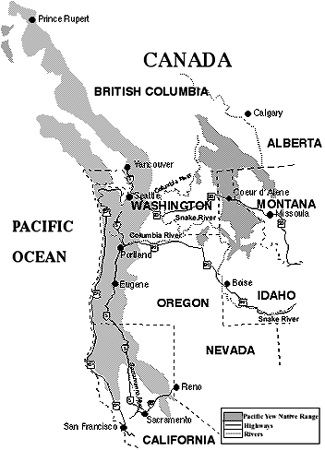
24
PACIFIC YEW (Taxus brevifolia)
Other names: western yew, yew, sometimes confused with hemlock)
EXCELLENT
This small and rather rare tree is found only along the Pacific Coast from northern California into southeastern Alaska, and west of the Cascades. It is the best possible bearing tree but is seldom found near a corner. It thrives in dense shade along stream banks but may be found on higher ground in dense forests. The original surveyors sometimes confused it with hemlock perhaps because of the somewhat similar needles, and habitat.
If the original notes call for a yew it will almost surely be there unless destroyed by fire, logging and road construction. The blaze is usually only partially healed with the scribe marks still visible. It is a very slow growing tree and seldom exceeds 10" or so in diameter. If dead and fallen the wood is nearly immune to decay.
If a yew is found near a corner use it for a bearing tree over any other. Keep the blaze as short and narrow as possible to prevent excessive injury to the small tree. Scribe carefully. Painting may help prevent weathering of scribe marks.
Note: The Pacific Yew was referred to as “a skookumwood” in GLO notes for a corner on the Tahuya Peninsula in Washington. Can’t recall the section township and range; somewhere near T23N, R2W.
The word “skookum” is Chinook Jargon for strong. I had my party chief ask his father if he’d ever heard the term and he knew right off what it was.
Michael N. Sprouffske, PLS
Right-of-Way Cadastral Surveyor
NW Region, R/W Update & Land Survey Office
